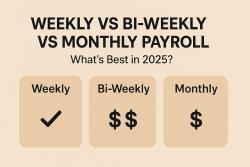
Weekly vs Bi-Weekly vs Monthly Payroll: What’s Best in 2025?
When it comes to paying employees, businesses have a few options. In 2025, just like in past years, many companies choose between weekly, bi-weekly, and monthly payroll schedules. But how do you know which one is right for your business?
Let’s break down each type of payroll and see the pros and cons in simple terms.
Weekly Payroll
What it means: Employees get paid once a week, usually on the same day (like every Friday).
Pros:
Employees love it – They get money more often.
Good for hourly workers or those who do shifts.
Easier to manage overtime hours quickly.
Cons:
More work for payroll staff – you have to run payroll 52 times a year.
Higher processing costs if you use payroll software or a service.
Bi-Weekly Payroll
What it means: Employees are paid every two weeks (usually every other Friday). This adds up to 26 paychecks a year.
Pros:
Still fairly frequent pay for employees.
Less stress on the payroll team – only 26 pay runs a year.
Easy to track hours and benefits.
Cons:
Can cause confusion during months where there are 3 paydays.
Not the best choice for monthly budgeting or for contract workers.
Monthly Payroll
What it means: Employees are paid once a month, usually on the last day of the month. That’s 12 paychecks a year.
Pros:
Less payroll work – only 12 runs a year.
Can save money on processing fees.
Good for salaried employees or higher-level staff.
Cons:
Employees have to wait longer for their money.
It can be hard for staff to budget monthly expenses.
Not great for hourly or gig workers.
So, What’s Best in 2025?
Here’s a quick way to decide:

Final Thoughts
Choosing the right payroll schedule depends on your business needs, employee preferences, and budget. In 2025, more businesses are looking for flexibility, accuracy, and easy-to-use payroll systems. Make sure to pick a system that works well for both you and your team.
